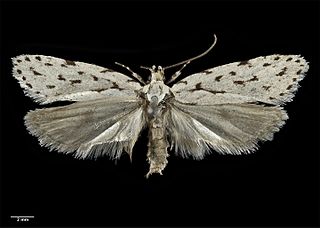
Izatha heroica is a moth of the family Oecophoridae. It is endemic to New Zealand, where it is widespread in the west part of the South Island. It has been collected in southern beech forests but larvae have been reared on dead kanuka or manuka bushes.
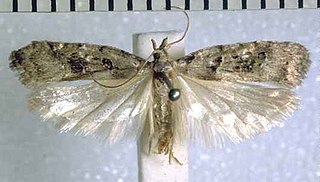
Heterocrossa canescens is a species of moth in the family Carposinidae. It is endemic to New Zealand. This species has been observed in Aoraki / Mount Cook National Park and in the Southern Alps. The larvae of this species feed on the fruits and flowers of endemic to New Zealand species in the genus Gaultheria. Adult moths are on the wing in November and from January to March.

Heterocrossa exochana is a species of moth in the family Carposinidae. It is endemic to New Zealand and has been observed in the North and South Islands. The larvae of this species feed on the fruits of Muehlenbeckia species. The adult is on the wing from September until May and are attracted to light.

Glyphipterix achlyoessa, commonly known as the cocksfoot stem borer, is a species of moth in the family Glyphipterigidae. It is endemic to New Zealand and can be found throughout the country. This species inhabits meadows and open grasslands. The larvae are hosted by species in the genus Juncus as well as by the species Dactylis glomerata. Adult moths are commonly on the wing from October to December.

Chersadaula ochrogastra is a species of moth in the family Oecophoridae. This species is endemic to New Zealand. It is classified as "Data Deficient" by the Department of Conservation.
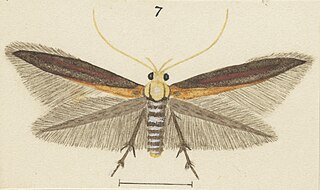
Stathmopoda endotherma is a species of moth in the family Stathmopodidae. It is endemic to New Zealand. It is classified as "At Risk, Naturally Uncommon" by the Department of Conservation.

Stathmopoda skelloni, the yellow featherfoot, is a species of moth in the Stathmopodidae family. It is endemic to New Zealand and can be found throughout the country. This species inhabits native forest, coastal dunes and shrubland as well as cultivated gardens and orchards. The larvae of this species feed on a variety of plant species including agricultural crops such as kiwifruit and persimmons. The adult moths are on the wing from September until March and are nocturnal but are attracted to light.

Planotortrix notophaea, the blacklegged leafroller, is a species of moth in the family Tortricidae. It is endemic to New Zealand. It was also present near Sydney in Australia, but this population is thought to be extinct.
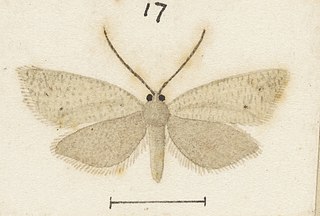
Ericodesma aerodana is a species of moth of the family Tortricidae. It is endemic to New Zealand and is found in the North and South Islands. The species inhabits sand dunes and larvae feed on Pimelea prostrata. Adults are on the wing from October to January and are active at twilight. This species is classified as "At Risk, Declining" by the Department of Conservation as its larval host plant is under threat from habitat loss and the invasive to New Zealand plant, sea spurge.

Gadira petraula is a species of moth in the family Crambidae. This species is endemic to New Zealand and is only found in mid Canterbury. G. petraula inhabits coastal, montane and low alpine rock sites. The larvae live in rock crevices in a silk shelter from which they emerge to feed. Their host plants are moss or lichens. The adult female is flightless and the male is on the wing in March. This species is classified as "At Risk, Naturally Uncommon" by the Department of Conservation. The 2010 and 2011 Christchurch earthquakes destroyed much of this species preferred habitat. Rock climbers cleaning rocks of the larval host plants are also a threat to the survival of this species.

Orocrambus jansoni is a species of moth in the family Crambidae. It is endemic to New Zealand. This species is classified as "At Risk, Naturally Uncommon" by the Department of Conservation.

Pyrgotis pyramidias is a species of moth in the family Tortricidae. It is endemic to New Zealand. It is classified as "At Risk, Naturally Uncommon" by the Department of Conservation. This species is regarded as having two 'forms' although doubt has been expressed whether these are the same species.

Pyrgotis transfixa is a species of moth of the family Tortricidae. It is endemic to New Zealand. It is classified as "At Risk, Naturally Uncommon" by the Department of Conservation.

Thambotricha is a monotypic genus of moths in the family Epermeniidae. Its sole known species, Thambotricha vates, is also known by the vernacular name wonder-haired prophet. It is endemic to New Zealand. This species is classified as "At Risk, Naturally Uncommon" by the Department of Conservation.
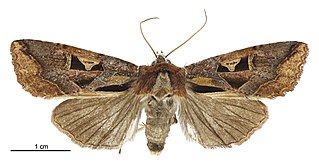
Meterana grandiosa is a species of moth in the family Noctuidae. This species is endemic to New Zealand. It is classified as "At Risk, Relict'" by the Department of Conservation.
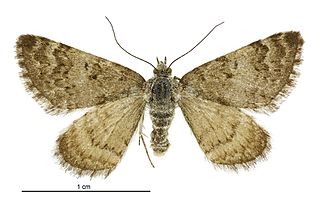
Paranotoreas fulva is a species of moth in the family Geometridae. This species is endemic to New Zealand and is found in the southern half of the South Island. The preferred habitat of this species are the salt pans of Otago, the mountainous grassland areas in South Canterbury and Otago and the glacial outwash terraces south of Tekapo. The larvae feed on Atriplex buchananii and Plantago coronopus. Adults are day flying and have been recorded as being on the wing in March, October and December. P. fulva is classified as "At Risk, Relict" by the Department of Conservation.
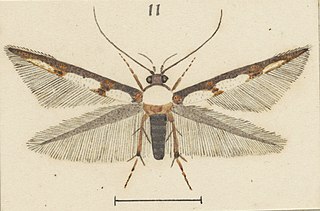
Stathmopoda aristodoxa is a species of moth in the family Stathmopodidae. It is endemic to New Zealand. It is classified as "At Risk, Naturally Uncommon" by the Department of Conservation.
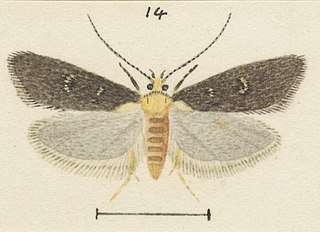
Trachypepla cyphonias is a species of moth in the family Oecophoridae. It is endemic to New Zealand and has been collected in Wellington and Taranaki. Larvae of this species have been reared from kānuka leaf litter. Adults are on the wing in December. This species is classified as "At Risk, Naturally Uncommon" by the Department of Conservation.

Xanthorhoe lophogramma is a species of moth in the family Geometridae. It is endemic to New Zealand and if found in the South Island. This species inhabits dry beech scrub but its larval host is unknown. Adult moths are on the wing in January. This species is classified as "At Risk, Nationally Uncommon" by the Department of Conservation.
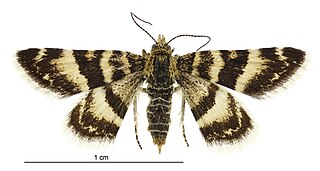
Notoreas ortholeuca is a species of moth in the family Geometridae. It is endemic to New Zealand.





















